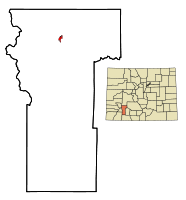Lake City, Colorado
| Town of Lake City, Colorado | |
|---|---|
| Statutory Town | |

Lake City ~ 1880
|
|
 Location in Hinsdale County and the state of Colorado |
|
| Coordinates: 38°1′48″N 107°18′37″W / 38.03000°N 107.31028°WCoordinates: 38°1′48″N 107°18′37″W / 38.03000°N 107.31028°W | |
| Country | United States |
| State | Colorado |
| County | Hinsdale County Seat |
| Incorporated (town) | September 19, 1884 |
| Government | |
| • Type | Statutory Town |
| • Mayor | Bruce Vierheller |
| Area | |
| • Total | 0.8 sq mi (2.2 km2) |
| • Land | 0.8 sq mi (2.2 km2) |
| • Water | 0.0 sq mi (0.0 km2) |
| Elevation | 8,661 ft (2,640 m) |
| Population (2010) | |
| • Total | 408 |
| • Density | 510/sq mi (185.5/km2) |
| Time zone | Mountain (MST) (UTC-7) |
| • Summer (DST) | MDT (UTC-6) |
| ZIP code | 81235 |
| Area code(s) | 970 |
| FIPS code | 08-42330 |
| GNIS feature ID | 0188715 |
| Website | Official Tourism Site = Official Site of Lake City and Hinsdale County |
The Town of Lake City is the Statutory Town that is the county seat and the only incorporated municipality in Hinsdale County, Colorado, United States. It is located in the San Juan Mountains in a valley formed by the convergence of Henson Creek and the headwaters of the Lake Fork of the Gunnison River about seven miles (11 km) east of Uncompahgre Peak, a Colorado fourteener. Lake City is named after nearby Lake San Cristobal. This area lies at the southern end of the Colorado Mineral Belt and when rich mineral deposits were discovered the native population was pushed from their tribal lands and the town of Lake City was incorporated in 1873.
With the completion of the first road into the mountains in this region, Lake City served as a supply center for the many miners and prospectors flooding into the area. As a supply center, the town boomed to as many as 3,000 to 5,000 settlers. But as the first-discovered deposits were found to be only moderately productive and no new extensive or rich deposits of minerals were found, by 1879 the boom had subsided. With the arrival of the Denver & Rio Grande Railroad in 1889, Lake City saw a second upturn in the economy that lasted into the 1890s. The railroad cut the cost of shipping gold and silver ores to smelters, reduced the cost of shipping supplies into Lake City, and provided shipment of cattle and sheep into the area for summer grazing in the high Alpine meadows.
By 1905, the mining era was over and Lake City entered a decades-long period of economic decline. Population figures hovered at 1,000 then dropped to 400 after 1910. Although mining continued throughout the twentieth century, it consisted primarily of exploration and speculation rather than productive operation. Beginning in 1915, visitors began coming to Lake City for the entire summer season and by the 1930s tourism had emerged as a viable industry.
...
Wikipedia
